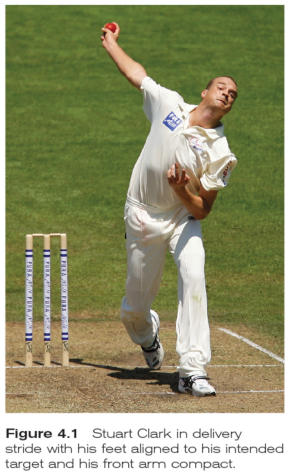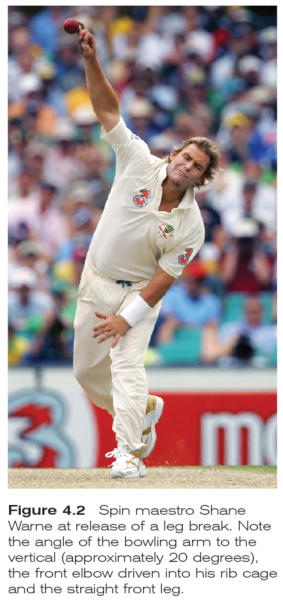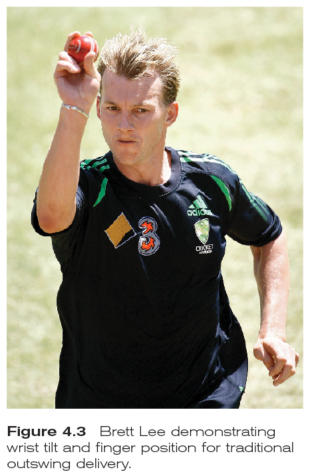Bowlers must understand the principles governing a sound bowling action. A mechanically sound technique can do much to ensure long-term involvement in the game with minimal interruption as a result of injury. As well, efficiency of technique can produce more effective outcomes in terms of generating power, spin or swing. Although it was not a major focus of this book to provide a comprehensive analysis of the skill of bowling, the players we interviewed mentioned some key aspects of technique, which we have summarised.
Quality pace bowling requires a smooth and accelerating run -up, a powerful and efficient bowling action and the capability to vary the line, length and speed of deliveries according to the perceived weaknesses of the batters and the circumstances of the game.
Because research has shown that the run-up in pace bowlers contributes approximately 20 per cent to the velocity of the ball, there has been more emphasis on bowlers’ run-ups. Dennis Lillee consulted a running coach to make sure he was accelerating effectively into the delivery stride. Others have followed suit, albeit somewhat late in their careers, as Merv Hughes indicated:
Being young you have a lot more on your mind than running style. This includes where you are going to bowl, what type of delivery and so on. Looking back now, the run-up, delivery and follow-through are the most important stages of bowling, with run-up the most important.
John Harmer believes that a bowler is an ‘athlete until the penultimate stride’, and so correct running technique is mandatory. Brian Mcfadyen contends that bowlers need an efficient run-up so that when they get to the crease, they don’t need to place enormous physical load on the body. As well as momentum, he believes the run-up should place the bowler in a balanced position at delivery. McFadyen warns that it is very difficult to alter the running technique of a 21-year-old, and suggests that most work should be done between 8 and 15 years of age.
The length of a pace bowler’s run-up has varied throughout the ages, but essentially it should be as long as needed to generate optimum momentum while enabling the bowler to be strong through the crease. Damien Fleming remarked that, like most young fast bowlers of his time, he initially ‘ran in like Dennis Lillee with a high bound in the penultimate stride’. Later in his career, he shortened his run-up from 28 paces to 15 and found that he maintained his pace, was taller at take off and release and had a shorter jump into the delivery, but most important, he felt more powerful and rhythmical.
John Harmer offered the following keys to achieving an effective body position in bowling:
- Leg stability with limited collapsing of the legs throughout the delivery
- Compactness of the arms so that all force is generated towards the target
- Alignment of all body parts inside the width of the bowler’s shoulders (see figure 4.1)
- An injury-free technique

McFadyen also stressed the importance of alignment, explaining that the bowler’s run-up and foot placement should be in a direct line to the target. Richard Done cited the stability at back foot landing, but added that the direction of the front elbow and the position of the hand and body at release are important points in a delivery.
All of the preceding tips are relevant to all types of bowling from pace to spin. The following section presents specific issues relating to spin bowling.
Spin Bowling
Spin bowling is a complex art that requires guile, effective grips, strong body action and subtle changes in flight to deceive a batter. Ashley Mallett identified the following principles in bowling spin:
- Ensure that the delivery action is supported by a strong, solid base.
- Stay tall through the crease, keeping the front leg straight and the leading arm high.
- Spend as much time on the front leg as possible, and use an up-and-over action to generate the energy required to spin the ball.
- The key is not where the ball lands, but how it arrives. The more time you spend on the front foot, the more purchase you will achieve on the ball. A hard-spun delivery with lots of overspin will cause the ball to dip acutely.
- If you spin the ball hard, you will have a bigger area of danger. For example, a Shane Warne leg break, shown in figure 4.2, achieves a danger area as big as a dining room table, but a more modestly spun delivery produces a danger area the size of a dinner plate.
- Off spin bowlers should keep their bowling arms higher than leg spinners do. In both cases, the front shoulder should point towards the target (to optimise rotation) and rotate like an upright wheel rather than sideways like a Frisbee.

A strong use of the leading, or non-bowling, arm has long been advocated for pace bowlers, but according to Terry Jenner and Ashley Mallett, it is just as important for spin bowlers.
Swing Bowling
The ability to swing the ball in a traditional manner has declined in recent years as many bowlers, like Glenn McGrath, have favoured moving the ball off the seam. Many experts believe that this phase will change in the near future, as Harmer noted: ‘Swing bowling will come back and is particularly suited in Twenty20 cricket. If the ball is straight, then you get very predictable and players are able to risk hitting through the line of the ball.’
Damien Fleming contends that the keys to orthodox outswing bowling involve positioning the wrist and fingers behind the ball with the ball angled towards the slips (see figure 4.3). With his wrist tilted to point the seam towards the slips, he imparted backspin on the ball as he slid his fingers down the seam at release. It was critical to maintain a stable seam throughout the flight path. Although some achieved this with two fingers close together, his preference was to have the fingers more apart (like Craig McDermott and Terry Alderman). Fleming also focused on placing his thumb right along the seam when he wanted to swing the ball. For cutters and slower balls, he recommended moving the thumb to one side of the seam.

Fleming also noted that some bowlers, such as David Saker (former Victorian and Tasmanian outswing bowler), swung the ball effectively by pointing the seam towards slips but with their fingers pointing straight up the pitch at release. The key then appears to be to set the ball in the hands to maintain a stable seam position pointing towards the slips. The opposite action is true for inswing bowling: the seam points towards leg slip and the wrist tilts to accommodate that angle.
For reverse swing, Fleming noted two strategies that seem to work. Initially, players bowled with a rounded arm action to facilitate reverse inswing. Bowlers such as Lasith Malinga and Waqar Younis generated late reverse inswing with this method. However, Fleming noted that, in recent times, Victorian fast bowler Shane Harwood and emerging Indian pace bowler Ishant Sharma achieve reverse swing with the seam upright. This fairly recent phenomena in cricket needs further investigation and practice to determine the best method.
In all swing bowling, bowlers must shine the ball appropriately to facilitate variation in smoothness on either side of the ball. According to Carl Rackemann, the late Malcolm Marshall transformed pace bowling. With his front-on action, he was able, through positioning his wrist correctly, to bowl outswing as well as the traditional inswing that is typically achieved with this action.
The information in this section is not meant to be a comprehensive coverage of techniques in bowling. Rather, it is intended to address the basics of sound technique. Players need to be persistent and learn to bowl both traditional swing and reverse swing deliveries to maintain potency in their armoury.